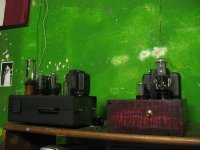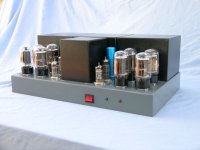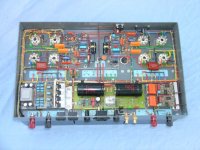Re: Re: BeeGee2
Maybe an H2 750 triple! Weeeeeeeeeeeeeeeeeeeellllleeeeeeeeeeeeeeee
Jeff
planet10 said:A Kawasaki?
Maybe an H2 750 triple! Weeeeeeeeeeeeeeeeeeeellllleeeeeeeeeeeeeeee

Jeff
Gerrit,
Most excellent! I love your fabrications; its inspiring.
Where did you get the raw silicon for those mounts? That is a clever idea. I have only used the silicon caulk before to mount caps in my amps, but it doesn't look half as planned. I had gotten that idea when I looked inside a Blue Circle BC3 Galatea preamp.
Most excellent! I love your fabrications; its inspiring.
Where did you get the raw silicon for those mounts? That is a clever idea. I have only used the silicon caulk before to mount caps in my amps, but it doesn't look half as planned. I had gotten that idea when I looked inside a Blue Circle BC3 Galatea preamp.
Gerrit,
Most excellent! I love your fabrications; its inspiring.
Where did you get the raw silicon for those mounts? That is a clever idea. I have only used the silicon caulk before to mount caps in my amps, but it doesn't look half as planned. I had gotten that idea when I looked inside a Blue Circle BC3 Galatea preamp.
Thank you very much for the compliment.
The silicone rubber is the kind used for making plaster casting molds. I got it at a DIY store but you can probably get it in any art supply store. Beware that it is pretty expensive (€50/Kg) and tricky to work with. The two components have to be mixed in exactly the right amount and it settles within 10 minutes, so be carefull not to mix too much at once.
BTW,
The copper heatsinks look much better than they work. The one I had planned for the HEXFET in the high voltage regulator was not good enough, I ended up using a normal aluminium heatsink (Fisher).
Re: EL84 PP monoblock update
can you please tell me more about this amp and where did you source the parts? you can email me. thank, tom!
gertk said:And this is the finished version
These amplifiers have been running for several hours without problems.
can you please tell me more about this amp and where did you source the parts? you can email me. thank, tom!
After browsing this thread (which takes a while) I'm glad to be able to post something different.
'Impressive' doesn't say enough in this case. Wow!!
Simon
'Impressive' doesn't say enough in this case. Wow!!
Thank you, thank you,
If you would like a closer look and listen, you're hereby invited. Maastricht is not that far.
I put a lot of time and effort into these amps as it is not my intention to build 'one amplifier after the other'. The next project is building a set of Replikon BL horns for the Fostex drivers.
If you would like a closer look and listen, you're hereby invited. Maastricht is not that far.
Thanks for the invitation, sounds very interesting as I haven't had much opportunity to hear other tube rigs and am definitely curious what levels of bliss can be achieved with a perfectionist setup. Would also be nice to compare one of my low-cost homebuilt SE's with that behemoth of yours. I'll gladly take a raincheck for after the exams and following ordeals.
I put a lot of time and effort into these amps as it is not my intention to build 'one amplifier after the other'.
Exactly opposite to my philosophy; I plan to build many different amps with different tubes / circuits to get a feel for the impact on sound each topology / component has. Ofcourse I'm practising for later opportunities to aim for a nec-plus-ultra
Simon
I'll gladly take a raincheck for after the exams and following ordeals.
Good luck with your exams!
Exactly opposite to my philosophy; I plan to build many different amps with different tubes / circuits to get a feel for the impact on sound each topology / component has.
Maybe not exactly opposite, I'm just working on a smaller scale. Even with a design this simple there are still a lot of things one can do. Bias current, plate voltage and primary load impedance are all more or less adjustable.
It's just that because the amp is such an improvement over my previous ones that the imperfections of the loudspeakers have moved to the foreground. I believe that amplifier, loudspeakers and listening room cannot be optimized in isolation. So now it is time to turn my attention to the loudspeakers again.
Good luck with your exams!
Thanks!
I checked the schematic and that's really something.... only saw that level of simplicity on high gm tube spuds. How much voltage swing do you need to feed the input trafo for full output?
Simon
How much voltage swing do you need to feed the input trafo for full output?
+28dBu or about 19V for 6.2W and the source has to be very low impedance. This definitely will not work with normal preamps but most 'pro' gear (like the Benchmark DAC1) can deliver that kind of signal. A lot of people think the high output level of the DAC1 is a problem, I made full use of it. The LL7905 can be wired in several modes (1:2.8 , 1:5.6 , 1:11.2) I use 1:2.8. The secondary can be used as a phase splitter so it can also be used to create a minimalistic push-pull configuration.
Balanced output preamp:
All measurements done with 1200 ohm load:
Frequency range: 10Hz to 110kHz (+0/-1dB)
THD: 0.25% (1Vrms), 1% (10Vrms) (2nd harmonic dominant)
S/N: 80dB (ref 1V)
Output impedance: 165 ohm
Max gain 3.8x/11.5dB
Max output signal before clipping: 20Vrms.
The output transformers perform excellent, and the semi separate power supply/amplifier chassis seems to pay off regarding noise/hum.
Jan E Veiset
An externally hosted image should be here but it was not working when we last tested it.
All measurements done with 1200 ohm load:
Frequency range: 10Hz to 110kHz (+0/-1dB)
THD: 0.25% (1Vrms), 1% (10Vrms) (2nd harmonic dominant)
S/N: 80dB (ref 1V)
Output impedance: 165 ohm
Max gain 3.8x/11.5dB
Max output signal before clipping: 20Vrms.
The output transformers perform excellent, and the semi separate power supply/amplifier chassis seems to pay off regarding noise/hum.
Jan E Veiset
Hi jane !
You have OPT out put 110KHz( Frequency range )?
Thas name perform ?
Wo ..!you have maching Ocopcilo test it for you of your seen Frequency in OPT ?
DIY number one !
But so look like tube 6H30P ? Im think soud verygood for thas tube !
I have one but not out put OPT, and use Capacitor Jensen0,47, Im waiting for Tango OPT N126 coming soon with me and choi for 5K setup with 6H30P russian you tink good of not ?!
So lucky guy !
You have OPT out put 110KHz( Frequency range )?
Thas name perform ?
Wo ..!you have maching Ocopcilo test it for you of your seen Frequency in OPT ?
DIY number one !
But so look like tube 6H30P ? Im think soud verygood for thas tube !
I have one but not out put OPT, and use Capacitor Jensen0,47, Im waiting for Tango OPT N126 coming soon with me and choi for 5K setup with 6H30P russian you tink good of not ?!
So lucky guy !
The preamp is based on Sowter transformers and triode strapped EL84.
Something like this:
An internal look in the amplifier section:
I will use this preamp as a front end for some class D solid-state mono blocks (B&O ICE-power).
Jan E Veiset
Something like this:
An externally hosted image should be here but it was not working when we last tested it.
An internal look in the amplifier section:
An externally hosted image should be here but it was not working when we last tested it.
I will use this preamp as a front end for some class D solid-state mono blocks (B&O ICE-power).
Jan E Veiset
- Home
- Amplifiers
- Tubes / Valves
- Photo Gallery


